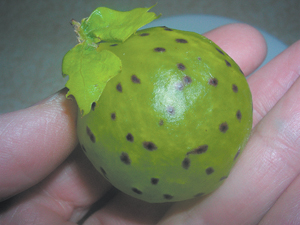WHAT IS THIS?
 Editors Note: Waynedale News reader Kathy Stark sent in a picture of something she found in her yard on Lower Huntington Road. She wanted to know what it was.
Editors Note: Waynedale News reader Kathy Stark sent in a picture of something she found in her yard on Lower Huntington Road. She wanted to know what it was.
I didn’t know, so I forwarded the information to Marty Benson, Assistant Director/Public Affairs and Publications, DNR Division of Communications.
Marty didn’t know so he forwarded the information to Michael J. Ellis, DNR Senior communications specialist and Assistant editor of Outdoor Indiana and Michael solved the riddle for us. The picture is of an Oak Apple Gall.
Oak apple galls are sometimes mistaken for an actual crop of the tree, such as apples on an apple tree, but are actually deformed leaves. The gall is about 1 ¼ to 2 inches or larger in diameter, globular, and smooth. The outside is green and darkens with age. The inside has a juicy, white, spongy substance with a small, hard center where the parasite is located. When the parasite leaves the gall, the gall dries and the insides become a mass of fibers.
Several species of gall wasps cause oak apples. Biorhiza pallida is one such insect and is a good example of the alternation of generations in insects that cause different gall stages. Alternation of generations is the alternation of different forms of an organism during a species life cycle. One generation often behaves and physically appears different from the second generation. The third generation may then behave like the first generation, the fourth like the second, and so on.
In May, a wingless Biorhiza pallida female inserts her eggs into the base of a vegetative bud. This activates the oak into the process of forming a protective structure, the gall, around the eggs.
The unilocular, multilarval oak apple gall matures in June and July.
By late July, full winged male and female wasps, that have developed in separate galls, exit the structures through exit holes.
The emerging wasps mate, while the deserted gall shrinks and blackens.
The fertile females burrow into the soil and insert their eggs into the oak tree’s roots.
Root galls form which are spherical, brown, unilocular, and unilarval.
These root galls mature in approximately 16 months.
Wingless females emerge, climb up the oak tree’s trunk, and lay eggs in the leaf buds.
The cycle continues to show alternation of generations.
Kathy said, “As soon as I found out what it was, I got it out of my house. The last thing I want is to have some wasp come crawling out of an alien looking growth while still in my house.”
- What To Know About Mosquito Season - July 19, 2024
- Local Worship & Events: July 19 Update - July 19, 2024
- Allen County Bar Foundation Announces Scholarship Winners - July 19, 2024


